Leveling off at 60 feet, I meticulously scanned Browning Wall’s carpeted ledges of pastel-pink soft corals, ghostly-white plumose anemones and big clumps of encrusting sulfur sponges. While stalking one of the Emerald Sea’s more elusive critters, I marveled at the living tapestry of rainbow colors. Stuffed into every nook and cranny of this precipitous drop off were sea anemones, feathery hydroids, deep-purple hydrocorals, spiny red urchins, rock scallops and lacy basket stars. Traveling slowly over a rock festooned with orange social tunicates were several flame-tipped nudibranchs and one Limacia cockerelli (formerly known as Laila cockerelli) nudibranch. Set apart from Browning’s ubiquitous schools of widow and China rockfish, beautifully mottled red Irish lord sculpins had perched themselves on invertebrate-encrusted outcroppings, seemingly expecting the ocean’s current to spoon-feed them their prey.
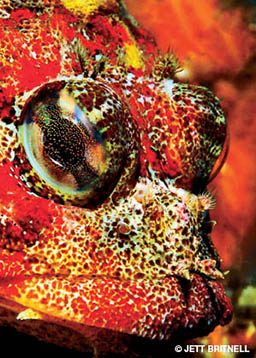
My quarry, a decorated warbonnet, peered out from behind some soft coral polyps. Skittish by nature, these eel-like fish were named after the prominent cirri crowning their skull, which resembles the feathers of a Plains Indian chief’s war bonnet. Measuring about one foot in length, these bizarre-looking fish rival any to be found at many of the world’s tropical diving hot spots in terms of vibrant coloration and exotic beauty. The water temperature was a balmy 49ºF, and I was adrift in underwater photographic bliss.
Browning Pass, a remote current-swept channel off Vancouver Island’s Nigei Island, is one of British Columbia’s diving jewels. There are numerous dive sites within this channel that feature a diverse assortment of subsea terrain and unusual marine life. John deBoeck, a local dive a operator who pioneered diving in Browning Pass, has proclaimed this waterway as having the best temperate diving in the known universe. It’s hard not to agree; the constellation of sea life inhabiting Browning Pass is out of this world. Seasonal upwellings — the movement of deep, nutrient-rich ocean water to the surface, combined with extreme tidal movement — produce an enriched planktonic broth that supports a lush assortment of exotic marine life outstanding in variety and abundance. British Columbia harbors approximately 7,000 marine species, or roughly 4 percent of the world’s total. Marine biodiversity experts believe this number could double once the province’s subsea terrain is fully explored.
Eagle Rock
Ribbons of kelp float like amber fronds through the Emerald Sea, pierced with brilliant shafts of sunlight flickering through the water column. Swimming through the kelp forest at Eagle Rock was akin to being in an aquatic cathedral. As swarms of tiny jellyfish drifted aimlessly around me, I paused briefly over a sandy ravine and marveled as a large herring ball swirled like quicksilver beneath the kelp canopy. Whenever the herring swooped close to the sea floor, several lingcod rocketed skyward with their mouths agape, leaving the water column flaked with silvery scales. Finning beyond the kelp’s sheltering canopy, I came across two wolf eels out in the open. Just beyond them, a giant Pacific octopus emerged from its rocky den. With average weights between 20 to 50 pounds and outstretched arm spans of up to 20 feet, these beguiling cephalopods are indeed behemoths. But appearances can be deceiving; despite their imposing size, in reality they are shy, intelligent, gentle and harmless creatures.
Seven Tree Island
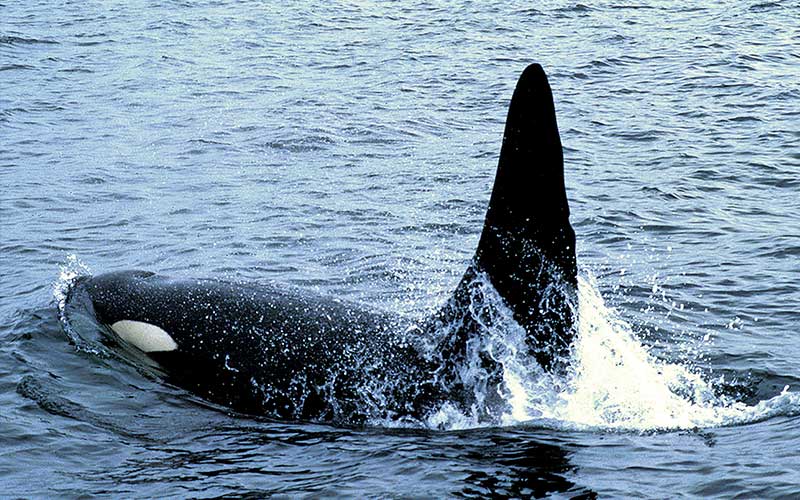
The tiny islet of Seven Tree Island is a remarkable dive site situated on the northwest rim of the pass. Along the eastern edge of the islet it is possible to descend deep as the steep wall cascades into the abyss, well beyond safe sport-diving depths. Highlighted with red and pink clumps of soft corals, billowy white Metridium anemones and large elongated dead man’s finger sponges, Seven Tree’s seascape presents an exceptionally scenic backdrop for underwater photography.
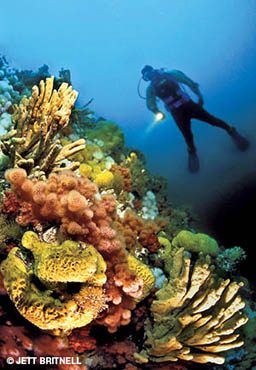
Marine life is diverse and abundant on Seven Tree’s western side, especially where the bottom shallows out and the rocky substrate changes to powdery white sand. Here it appears more “tropical” than some South Pacific reefs. Orange sea pens and a variety of sea stars dot the sandy plain. Speckled sand soles flee across the bottom like miniature magic carpets. Punctuating the nearby wall’s rocky face were the requisite soft corals, giant barnacles, octopuses, candy-striped shrimp and anemones galore. Fist-sized orange peel nudibranchs foraging on soft coral polyps are likewise part of the seascape. Current-swept dive sites within the pass, like Seven Tree Island, can be dived only during the calm respite at slack tide intervals, unless one prefers to do a drift dive along its wall. While it is possible to circumnavigate this squat islet during a one-tank dive, I prefer to focus my lens on smaller sections of Seven Tree’s fabulous reef topography.
Browning Pass and its environs support one of the planet’s highest concentrations of sea mammals. Orcas, dolphins, harbor seals, Steller sea lions and seasonal migrants such as humpback and minke whales are all seen in the channel. In recent years, sea otters also took up residence here, and their population seems to be flourishing.
Browning Pass’ magical marine wilderness holds its own with any of the world’s great diving destinations. While the ocean may be cold this far north of the equator, the subsea splendor is remarkable. It’s worth dressing for cold water, because at Browning Pass, you’ll never endure mediocrity. Whether a recreational diver, tech diver or underwater photographer, discovery awaits those who are willing to take a dive on the wild side.
How To Dive It
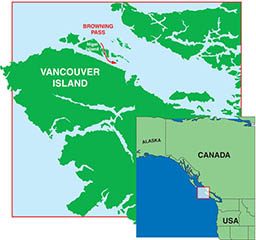
Conditions: Appropriate scuba equipment is essential to enjoying cold-water dives. The first thing one requires is good thermal protection in the form of a neoprene or shell-style drysuit or a quarter-inch wetsuit. A cold-water hood and dive gloves are required for diving comfort in summer or winter. BCDs may need to fit larger than usual due to the thicker wetsuits or drysuits. Additionally, warm-water fins will likely not have large enough foot pockets when worn with a thicker dive suit. Check that everything fits before leaving home. Other handy items include an underwater compass and dive light. Also important is appropriate training; currents can be swift and tricky at times, so be sure you’re comfortable and able to dive safely in a current.
Most sites in the pass are dived during slack water intervals and employ a boat and captain for water entries and pickups. Surface water temperatures range from 54ºF to 64ºF, but at depths below 30 feet temperatures hover around 40ºF. Winter temperatures average a chilly 45ºF. September through December underwater visibility ranges from 50 to 100-plus feet and reduces to 20 to 70 feet during seasonal plankton blooms in the spring and fall.
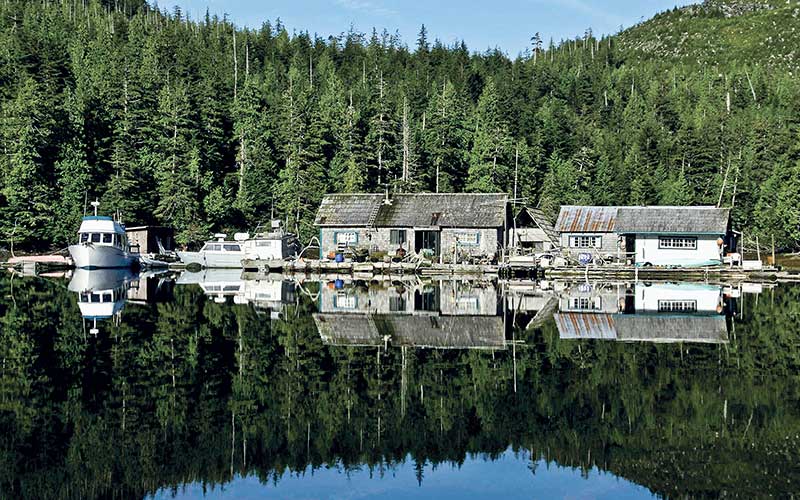
GETTING THERE: To get to Browning Pass, you must fly or drive to Port Hardy, which is located four hours north of Nanaimo by car on the east coast of Vancouver Island. The dive operator picks up divers at the government dock and transports guests by boat to the dive lodge, which is in secluded Clam Cove, just a short dive boat ride to Browning Pass dive sites. For ferry schedules from Vancouver to Nanaimo, call B.C. Ferries at +1-888-223-3779 or +1-250-386-3431; B.C. Ferries.
DIVE OPERATORS: Browning Pass HideAway Dive Lodge (all-inclusive dive packages), +1-877-725-2835 or +1-250-753-3751; vancouverislanddive.

© Alert Diver — Q4 Fall 2010